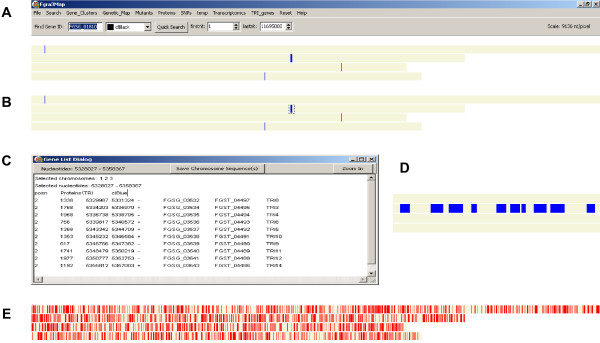Figure 1.
Screenshots of OmniMap displaying the four Fusarium graminearum chromosomes and gene information. (a) TRI genes displayed by selecting the TRI_genes menu from the top menu bar. The four chromosomes are drawn to scale in grey and the genes are displayed in blue. The species specific OmniMap name, Fgra3Map, is displayed top left. The other menu features shown are described in the main text and Table 1. (b) Selection of the main cluster of TRI genes in the middle of chromosome 2 using the mouse. The selected region is shown as a dashed rectangle. (c) This shows the text data for the TRI gene cluster selected in panel b. The third line of the text window: posn TRI_genes\TRI_genes clBlue indicates the data file was of type "posn", its path relative to Fgra3Map.exe was "\TRi_genes\TRI_genes.posn" and the genes are displayed in blue. The following 10 lines give information about each gene. The columns from left to right cover chromosome id, gene length (nt), first nt of gene, last nt of gene, the coding DNA strand, gene id (assigned by BROAD) and the gene annotation [7]. (d) A 'zoomed in' display of the chromosome region selected in panel (b), revealing the presence of the 10 TRI genes (blue boxes). (e) Genome wide distribution of the 2,002 F. graminearum genes which are considered to be species specific (BLAST E-value cut-off: e-10). The data files were produced from the Fusarium graminearum Genome Database (FGDB) at the Munich Information Centre for Proteins Sequences (MIPS) version FG3.

